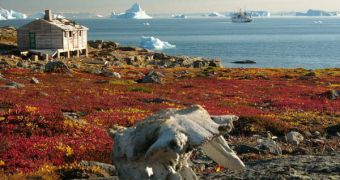For quite some time now, researchers have known that the vast amounts of carbon dioxide that are stored in the Arctic permafrost (frozen soils, river deltas and other sediments) will in the future play a significant part in the warming of the planet, but they never had a clear idea of just what extent this influence will reach. A new study comes to highlight the fact that the amount of greenhouse gases that are trapped in the soils are actually twice as large than first estimated, which means that the threat they pose to the world is twice as big.
“We now estimate the deposits contain over 1.5 trillion tons of frozen carbon, about twice as much carbon as contained in the atmosphere,” says the lead author of the new study, Dr.Charles Tarnocai, of the Agriculture and Agri-Food Canada, in Ottawa. The research is very worrying because it raises more questions as to just how much carbon dioxide and methane will be released into the atmosphere when the permafrost melts. Already, signs of decay have appeared, and methane emissions coming from the Arctic have spiked in recent years.
If only one tenth of the greenhouse gases stored under the permafrost are released into the atmosphere, then the levels of carbon dioxide in the air will be brought up to a level never before encountered. Countless animal species, plants and ice sheet are endangered by only a 2-degree Celsius rise in global temperatures, but a vast amount of hydrogen could bring about the forecast Arctic and Antarctic meltdown a lot sooner than anticipated.
“Radioactive carbon dating shows that most of the carbon dioxide currently emitted by thawing soils in Alaska was formed and frozen thousands of years ago. The carbon dating demonstrates how easily carbon decomposes when soils thaw under warmer conditions,” explains University of Florida professor Ted Schuur, the co-author of the new research.
“Permafrost carbon is a bit of a wildcard in the efforts to predict future climate change. All evidence to date shows that carbon in permafrost is likely to play a significant role in the 21st century climate given the large carbon deposits, the readiness of its organic matter to release greenhouse gases when thawed, and the fact that high latitudes will experience the largest increase in air temperature of all regions,” explains the Executive Director of the Global Carbon Project at CSIRO, in Australia, Dr. Pep Canadell.
According to the work that the researchers published in the latest issue of the journal Nature, most of the permafrost is at this point in time located in Canada, Greenland, Kazakhstan, Mongolia, the Russian Federation, the Scandinavian countries and the US. The study regarding the carbon dating measurements was published in this week's issue of the journal Global Biogeochemical Cycles, ScienceDaily informs.

 14 DAY TRIAL //
14 DAY TRIAL //